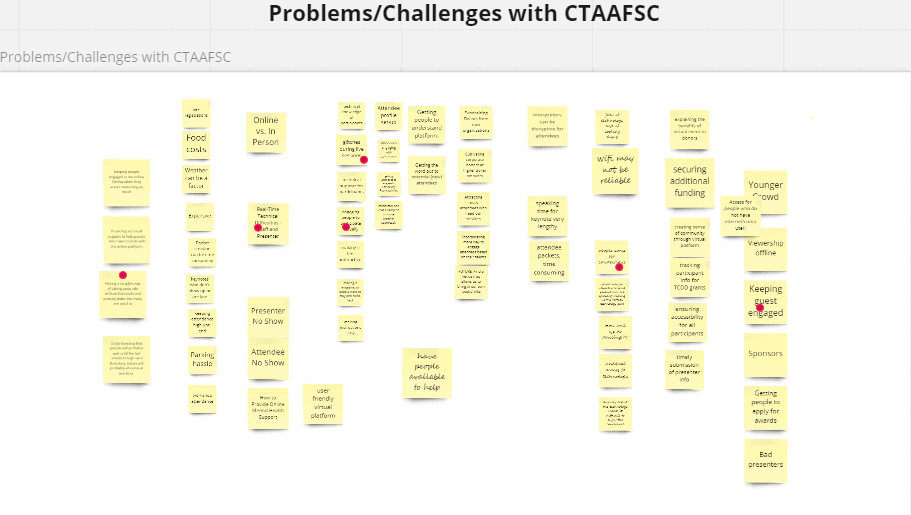Case study read time = 5-8 minutes
Overview
Project Scope: 1 hour
Project Type: Brainstorming, Teaching
Role: UX Researcher, Presenter, Facilitator
Tools: Miro, Microsoft Teams, Timer
UX Techniques: How Might We (HMW), Rapid Ideation, Effort/Impact Scale
Those Involved: Integral Staff Communications Division (12 People). Including the Chief Strategist (CSO) and Director of Communications.
Background
The inaugural conference, held in November 2000, was the first conference in Texas and only the third in the United States to focus on the healthcare needs of African Americans. The conference was born from a desire to confront the systems and cultural bias that have resulted in Africa Americans facing barriers to health care access. Tools and resources that build well-being have often been out of reach for this community. The belief that when people have a strong foundation of physical and mental health, they can reach their full potential drove the creation of the conference.
The conference is hosted by Integral Care, the Local Mental Health and Intellectual and Developmental Disability Authority for Travis County.
Problems
Staff members were tasked with leading a department meeting. Employees were allowed to present or train on any topic that might be beneficial or interesting to the staff. The team is made up of mostly extroverted individuals which is great but not always ideal when brainstorming because some introverts are always as comfortable speaking up during discussing and tend to be washed out by extroverts. For this reason, I decided to focus on a brainstorming activity for the staff.
Solution
Introduce design thinking and asynchronous software (Miro) to expedite and improve the ideation/brainstorm process. Also, allow for equal opportunity of participation.
My Role
I conceptualized and facilitated the project.
Part 1/8 – Challenge Statement
7 minutes of Rapid Ideation
For this workshop I wanted the team to begin to idea and solve solutions involving our major conference, the Central Texas African-American Family Support Conference (CTAAFSC), which would be virtual for the first time. I started the conversation by asking the staff to use sticky notes and to generate as many problems and challenges with CTAAFSC they were given 7 minutes with no discussion.
This activity generated 70 ideas. Most importantly it helped the staff begin to think and emphasize from a user experience standpoint, which is paramount to creating user-centered solutions.
Part 2/8 – Presentation
10 Minutes – You have 5 seconds!
For step 2 of this workshop, the team spent 10 minutes presenting their problem/challenge. Participants could choose as few or as many ideas they wanted to present, but they were only given 5-10 seconds to talk about the idea. This open session allowed the extroverts to relieve some stress of having to hold in their ideas, and it was a positive experience for introverts because public speaking was held to a minimum. I keep time on participants and if they started to go over the 10 seconds allotted i would instruct them to move to their next idea. I did this in order to keep the team from starting to figure out solutions, I just wanted ideas.
Part 3/8 – VOTE & ORGANIZE
4 Minutes
Step 3: After presentations, the team was given 3 minutes to vote for their favorite idea(s). Each member was allocated 2 red dots to use how they see fit. After voting ended, I took and organized the top 4 ideas (1 minute). Once again no discussion during this phase.

Part 4/8 – How Might We (HMW)
7 Minutes
Going into step 4 was exciting because I was able to implement another big UX tool, how might we statements! Well in our case, questions.
For this portion, the team was allowed to discuss the top-voted problem/challenges and reframe the problem/challenge into a question.
After 5 minutes of discussion, the team took 2 minutes to vote for their favorite HMW Question.
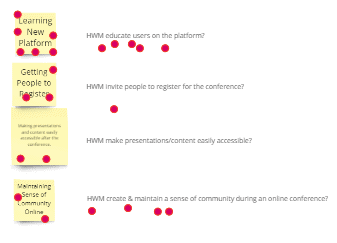
Part 5/8 – Back to Ideation & Voting – 7 Minutes
Step 5: Back to the drawing board, but this time following the HMW generated statement How might we educate users on the platform?
This process generated 35 solutions! The team got 5-10 seconds to talk about their solution(s), then spent 1 minute voting their favorite solution. This time everyone only received 1 vote.
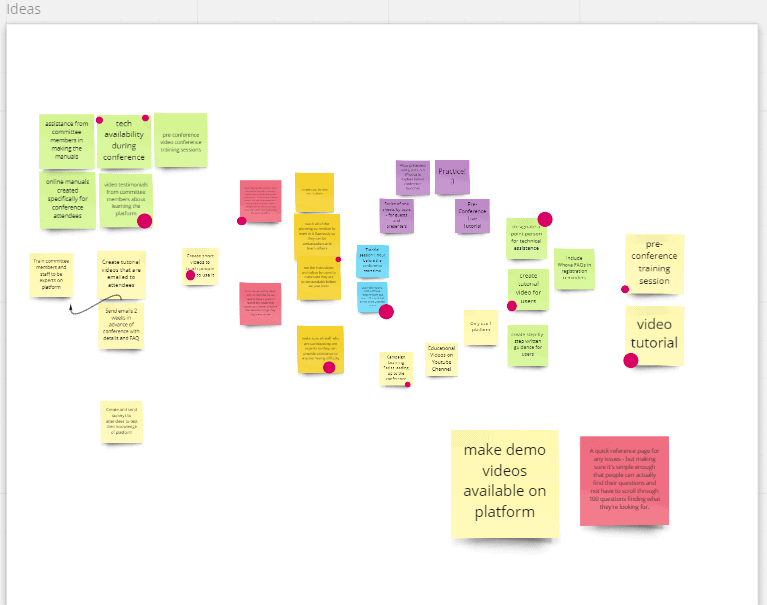
Part 6/8 – Prioritization –
3 Minutes
After voting ended the team moved into prioritization and sudo-affinity mapping. We separated all the sticky notes that received votes, combined those that were similar, and kept the top 5.
Part 7/8 – Effort/Impact Scale –
5 Minutes
In step 7 I introduced the effort/impact matrix. At this point, the team talked about how viable the 6 current solutions were.
The individual whose solution made the board could answer questions and expound on what they were trying to convey in the solution.
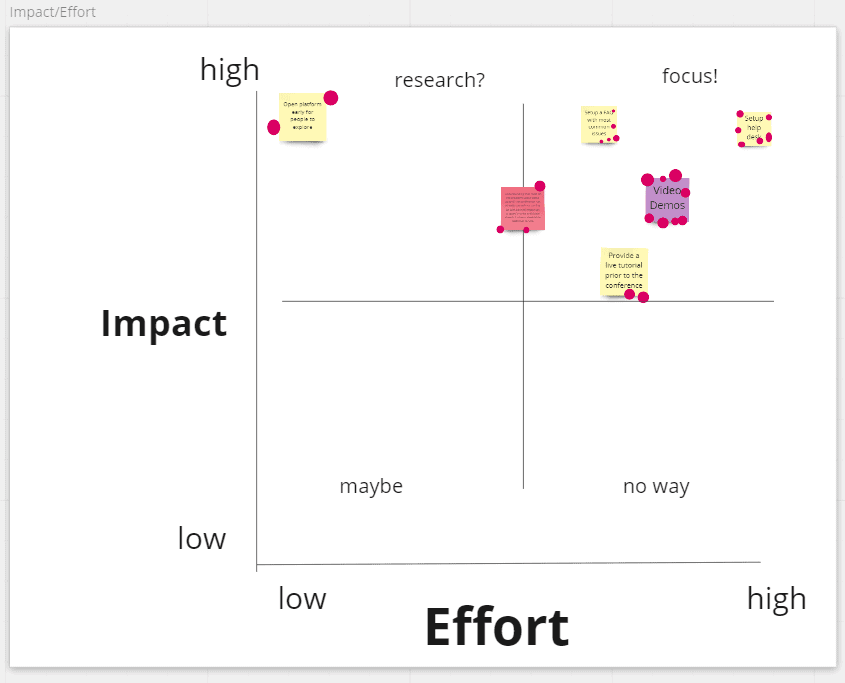
Part 8/8 – Actionable Items!
10 Minutes
The final and maybe most of the important step of the workshop was creating actionable tasks for the solutions that were chosen.
Through discussion, the team was able to create a viable solution that would not only have a high impact but would be fairly easy to implement.
A live Chatbox was implemented. This allowed the conference to accomplish over 50% of the solutions that were generated.
The chatbox accomplished:
- Having a help desk
- Creating a FAQ
- Live tutorials
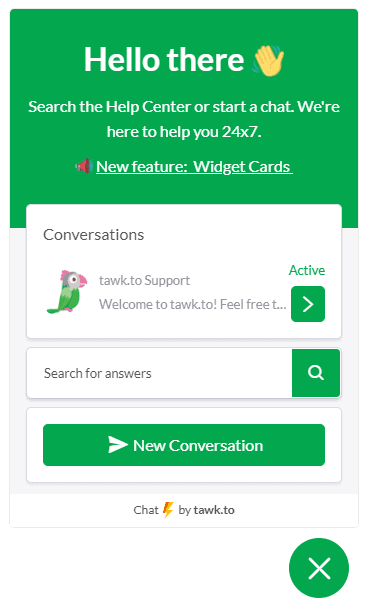
Project Learnings
Having a design thinking mindset can help lead teams through real solutions in a much more efficient pattern. One of the best solutions came from a person who is typically quite in meetings, so learning how to get the best ideas out of the entire staff is paramount.
I also learned that during design thinking workshops time can easily get away from you, so it is important to leave quite some buffer time around the activity.

